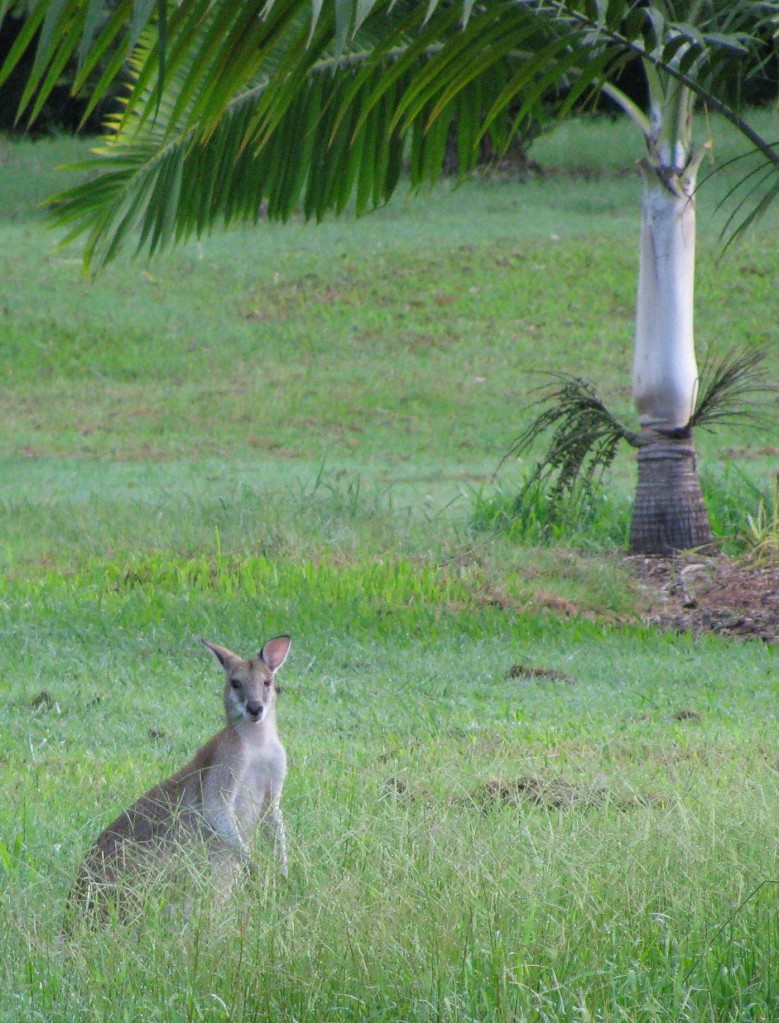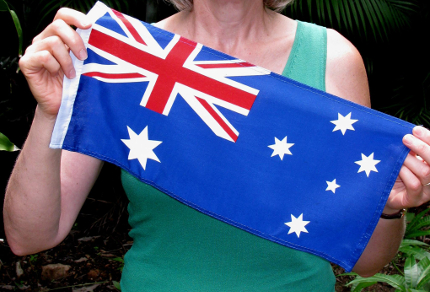
Agile Wallaby at Palmetum Park (© Magi Nams)
A crescent moon greeted me as I cycled away from home in the darkness of 5:30 a.m. The air was refreshingly cool after rain overnight, with the mellow sounds of crickets and awakening birds unexpectedly comforting. Flying foxes flapped eastward into the dawn, and the exercise equipment on the fitness track rested motionless and deserted. As darkness lifted into day, serene reflections of broad-crowned, riverside trees decorated the glass surface of the Ross River.
In Townsville’s Palmetum Park, 10 brush-turkeys scurried toward me as though saying hello and then scratched and pecked in the lawn and beneath rainforest trees. Bush stone-curlews in the succulents/cactus garden ducked behind boulders, and two agile wallabies bounded across open savannah. A magpie goose, three royal spoonbills, and several egrets foraged in the shrinking marshland habitat, while a white ibis perched atop a nearby snag, basking in the early morning sunshine.
I learned that palms growing at the edge of the pond and having drooping, split fans of leaves are called spiny palas, and that the red-stalked palms I noticed last week are lipstick palms or sealing wax palms. This morning, both purple and white blossoms of water lilies rose above the water’s surface, which was periodically thrashed into bubbles by violent eruptions of motion within the pond, presumably generated by fish.
Rainbow lorikeets squawked high in trees, their vivid plumages echoing the colours of the lipstick palms. Again, near the Palmetum, groups of Kreffts turtles swam in the still creek, their carapaces like shields, their clawed and webbed feet stretched wide as they stroked against the water.
I returned to the house in time for a good-bye kiss from Vilis, and then, having enjoyed my nature fix for the day, settled peacefully into what I described to my husband as my year-long independent study of Australia.
Since watching Ten Canoes, questions about early Aboriginal culture and the collision of Aboriginal and European cultures after Cook’s discovery have teased my mind. Seeking answers, I turned to Geoffrey Blainey’s A Shorter History of Australia. There, I discovered that the first Aborigines arrived on this continent more than 50,000 years ago. They came from Asia via Indonesia over many generations, at a period in the earth’s history when the oceans were much lower because huge icecaps covered a quarter of the earth’s surface. Using simple canoes or rafts, these people discovered a huge landmass that was uninhabited by humans and became adept at surviving its rigours.1
In learning to survive in their new home, the Aborigines became nomads, seeking out hundreds of particular plant and animal foods that became available during different times of the year. They didn’t grow crops, hoard food, or raise livestock. They built simple huts for shelter when needed and traveled lightly, carrying fire with them from place to place. They lived close to the land, in what some Europeans who later arrived in Australia thought was a barbaric lifestyle. They couldn’t boil water because they had no pottery, but they produced rock paintings of stunning complexity.2 In short, they lived a lifestyle totally at odds with the materialistic, mechanized, agriculture-oriented vision of the post-Industrial Revolution Europeans who came to Australia after Cook reported his findings.3
Although Arthur Phillip, the first governor of the newly established British colony, treated the Aborigines with respect and kindness, many of the settlers who followed despised them as an inferior race and were afraid of them.4
In the end, wool was the reason for the Aborigines’ downfall. Along with huge ships and houses, clothing, guns, iron tools, and strange habits, the Europeans brought with them animals previously unknown to this continent. In particular, they brought sheep. And, when Mother England increased her demands for wool in the early 19th century, Australian graziers pushed sheep farther inland onto more and more land the Aborigines had inhabited for tens of thousands of years.5
The fledgling government couldn’t control the graziers or woolgrowers, and violent clashes broke out. Such clashes were initiated by both Aborigines and Europeans, but the Aborigines suffered ten times the fatalities that the Europeans did. Sometimes whites chased blacks on horses, rounded them up, and massacred them using guns.6
There was no holding the Europeans back, no setting aside vast regions for the Aborigines to use as they always had. The whites invaded, and while colonial bureaucrats tried to figure out how best to deal with the Aborigines, the graziers took what they wanted. In 1838, two massacres of Aborigines occurred in northern New South Wales, with a total of over 200 Indigenous people killed. After the second massacre, at Myall Creek, seven Europeans were convicted and hanged.7 All this, I learned from Blainey’s history. The violence that accompanied the expansion of the wool industry in Australia marked an overtly destructive stage in the collision of Aboriginal and European cultures. A more insidious stage – The Stolen Generations – came later, and I’ll devote a post to it soon.
After supper, while Vilis and I walked home from Coles, I could not stop looking at the clouds. They billowed high in shades of milky blue and periwinkle, some kissed with pink, some swirled into lenticular shapes. All were components of a single panoramic scene that towered with beauty and seemed filled with some subtle danger. On the ground, warm air caressed me, as though it held tropical seduction in its breath. In a trashy sort of way, the feeling was echoed by the glaring neon signs of Bowen Road’s string of motels inviting customers in. Yet, when we turned off from Bowen Road, the trash evaporated into clean dusk. We were left with the clouds, the inviting warmth, and with flying foxes streaming through the sky toward fruit and nectar.
Reference:
1. Geoffrey Blainey. A Shorter History of Australia. 2000. Random House Australia Pty Ltd, Sydney, pp. 3-5; 2. Ibid, pp. 7-10; 3. Ibid, pp. 23-24; 4. Ibid, pp. 32, 46; 5. Ibid, pp. 40-45; 6. Ibid, pp. 41-42, 45-46; 7. Ibid, pp. 46-49, 306.


